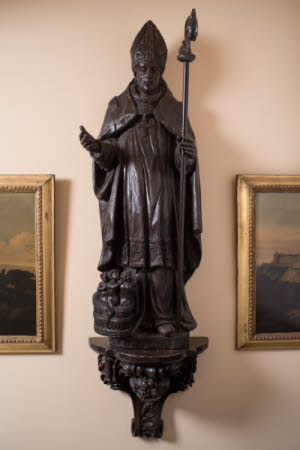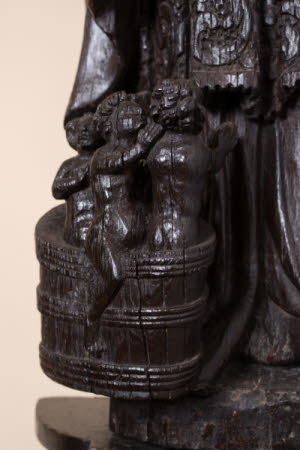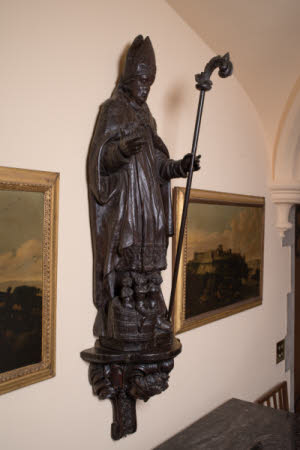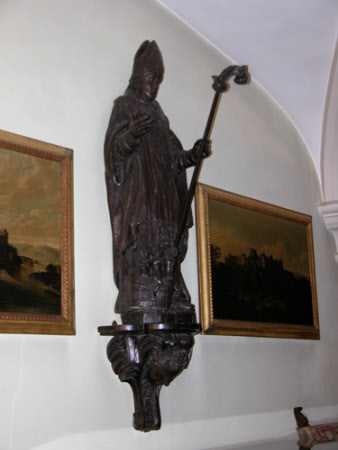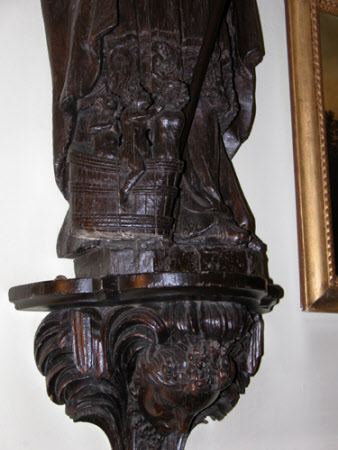Saint Nicholas of Myra (or Bari) with the three boys.
attributed to Flemish School
Category
Art / Sculpture
Date
c. 1650 - 1700
Materials
Oak
Measurements
1510 x 440 x 240 mm
Place of origin
Flanders
Order this imageCollection
Anglesey Abbey, Cambridgeshire
NT 514390
Summary
Oak wood; Saint Nicholas of Myra or Bari; Southern Netherlands (Flemish); c. 1650-1700. A carved oak statue of Saint Nicholas of Myra, with the bishop extending his hand in blessing. At his feet are the three boys in a barrel, referring to one of the legends of Saint Nicholas, in which Nicholas discovered the bodies of three small boys in a cask and revived them by making the sign of blessing over them. Made in the Netherlands in the second half of the seventeenth century.
Full description
A carved oak statue of Saint Nicholas of Myra, depicting the saint standing frontally, dressed as a bishop, his left hand holding a crozier, his right extended in a gesture of blessing. Over his surplice he wears a chasuble fastened at the front with a morse (clasp) in the form of a cherub head, from which is suspended a plain crucifix. On his head is a bishop’s mitre. At Nicholas’s feet is a separately carved section, attached to the main sculpture by means of a hook and ring, with the three boys in a barrel, referring to one of the legends of Saint Nicholas, in which Nicholas discovered the bodies of three small boys drowned in a cask and revived them by making the sign of blessing over the children. The sculpture is mounted on a seventeenth-century oak bracket, terminating in a scroll from out of the top of which emerge palm leaves and a female mask. This is one of two Netherlandish wood sculptures at Anglesey Abbey depicting the fourth century saint, Nicholas of Myra (or Bari). Although Nicholas has long been one of the most popular of all Christian saints, almost nothing is known of his life. Nicholas was the Bishop of Myra in Lycia, in the south west of modern Turkey. From an early age he devoted his life to the service of God and became a priest. When his rich parents died, Nicholas distributed their wealth to the poor. The cult is documented from the sixth century and was long centred on the saint’s shrine at Myra. However, in 1087, after Myra had come under Ottoman control, the saint’s body was stolen by a group of Italian merchants and brought to Bari in Southern Italy, where it remains to this day, kept in the Basilica of Saint Nicholas. Saint Nicholas became one of the most venerated and popular of saints; he is the patron saint of sallors, of Russia, Greece, Sicily and of the city of Aberdeen. Many legends are associated with Saint Nicholas, not least his extensive patronage of children and love of making gifts, which led to the development of the modern figure of Santa Claus. Among the acts attributed to Nicholas is his gift of three bags of gold to three young girls whose father had lost all his money, in order to provide them with dowries and rescue them from prostitution. Nicholas also rescued three unjustly condemned men from execution, as well as three young boys, the episode depicted in both the sculptures at Anglesey Abbey. On visiting a certain city, Saint Nicholas discovered that a wicked innkeeper was in the habit of stealing small children, which he killed and served to guests as meat. Nicholas searched the inn and discovered the bodies of three young boys being salted in a barrel of brine. On making the sign of the Cross over them, the children were brought back to life and clambered quickly out of the cask, as seen in the sculpture. Because of this and other miracles, Nicholas is also worshipped as the patron saint of small children. Both the sculptures of Saint Nicholas blessing the small children were early acquisitions by Lord Fairhaven. Both were recorded as early as the 1932 inventory of the art collection at Anglesey Abbey and this large figure may be seen in an article published in 1930. It is somewhat later than the other smaller sculpture, which was possibly made in Bruges in the early sixteenth century (NT 314577). Jeremy Warren November 2021
Provenance
Urban Huttleston Rogers Broughton, 1st Lord Fairhaven (1896-1966), acquired by 1930; Anglesey Abbey inventory 1932, p. 30, Entrance Hall, valued at £100; Anglesey Abbey inventory 1940, p. 27, Entrance Hall, valued at £100; bequeathed in 1966.
Makers and roles
attributed to Flemish School, sculptor French or Flemish School, sculptor
References
‘Anglesey Abbey, Lode, Cambridgeshire. An Inventory and Valuation of Furniture, Pictures, Ornamental Objects, Household Effects and A Collection of Miniatures.. prepared for Insurance Purposes’, Turner, Lord and Ransom, November 1932, p. 30. 'Anglesey Abbey, Lode, Cambridgeshire. An Inventory and Valuation of Furniture, Books, Ornamental Items & Household Effects .. prepared for Insurance Purposes’, Turner, Lord and Ransom, April 1940, p. 27. Oswald 1930: Arthur Oswald, ‘Country Homes, Gardens Old and New: Anglesey Abbey, Cambridge. The Seat of Lord Fairhaven and Capt. The Hon. Henry Broughton’, Country Life, 27 December 1930, pp. 832-38., p. 834, fig. 3.
